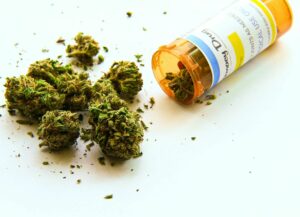Cannabis has always been associated with appetite stimulation – that sensation you feel soon after consuming marijuana – some folks call it "the munchies". Well, now science is beginning to back up that association. Research has shown
that cannabis does have a positive effect on appetite. For people whose
appetite has been affected by chronic illness, this is encouraging news.
Cannabis may help restore their appetite, allowing them to eat and
back on the path to good health.
Critical Illness and Appetite
People who are sick often do not eat or take in sufficient quantities of
food, and malnourishment is common among the critically ill. A
study of patients in a
hospital found that 40 percent of critically ill patients were
malnourished upon admission and that their status often deteriorated
across the hospital stay. Furthermore, malnourishment often lingers for
a period of time after
discharge, which
delays the healing process.
While symptoms of a patient’s chronic illness, including nausea,
vomiting, and chronic pain, may contribute to the inability or lack of
desire to eat, there are actual biological changes that impair appetite.
For example, critically ill patients have significantly lower levels of
ghrelin, a hormone produced by the gastrointestinal tract. This hormone
is associated with appetite stimulation and is at its highest levels
after fasting and prior to eating. In critically ill patients, ghrelin
[is significantly lower](https://www.ccforum.com/content/10/1/R10# B2)
than in healthy individuals. Levels of the peptide hormone leptin are
similarly affected. This hormone is associated with energy balance,
increasing appetite when the body’s energy is low.
Studies of those who suffer from anorexia
nervosa,
a mental illness in which patients have a distorted body image and avoid
food, may provide insight into the effects of illness-induced anorexia.
These studies have found that among anorexia patients:
- The site in the brain that associates taste with
pleasure
is underactive - Levels of
neurotransmitters,
brain chemicals that transmit messages between nerve cells, are
altered - Structural
brain changes, including reduced gray matter, occur - Depression and anxiety are high
The Endocannabinoid System and Appetite
In addition to ghrelin and leptin, the
endocannabinoid
system in the body can affect appetite. This complex system includes
cannabinoid receptors in the central and peripheral nervous system, as
well as in the immune system, and is associated with balance or
homeostasis. Some of these receptors, particularly CB1 receptors, are
concentrated in portions of the brain that affect memory, movement,
emotions, higher cognition, and
appetite. Naturally
occurring cannabinoids produced by the human body bind with these
receptors to create balance. Disrupting this binding can either reduce
or increase the effects on memory, emotions, and appetite. Disruptions
can be caused by medication, illness, and cannabinoids from cannabis.
THC and Appetite
Delta-tetrahydrocannabinol
(THC),
is the most common cannabinoid in cannabis and is responsible for the
high associated with the plant. THC is also responsible for stimulating
appetite.
THC binds with CB1 receptors, including those associated with taste and
pleasure, food intake, and energy balance. When THC is taken in, it is
rapidly taken up by the CB1 receptors and appetite is enhanced, eating
is more pleasurable, and the feeling of satiety (fullness) is reduced.
In addition to enhancing CB1 receptors in the brain, THC also:
- Improves sense of smell. A recent
study
of mice found that THC enhanced their ability to smell food, thus
increasing the amount of food they eat. - Improves
taste. THC
increases the ability to taste food, making it more pleasurable to
eat and increasing the rewards associated with eating. - Increases levels of ghrelin and
leptin,
Taking Cannabis
Medical cannabis comes in a variety of forms and can be taken a variety
of ways. Smoking, which introduces the cannabinoids to the system
quickly, may be difficult for people who are feeling nauseous. For those
suffering from vomiting, an edible form of cannabis may not be
effective. Luckily there are a number of alternatives, including:
- Cannabis oil – a concentrated form of cannabinoids that can be
placed under the tongue (sublingual) or added to food, drink
or tablets. - Vaporization –
this process involves heating the cannabis to a point below
combustion (burning) and inhaling the vapor created. Benefits
include fast delivery of cannabinoids and reduced effects on
the lung.
Another option is Marinol®. This
synthetic form of THC has been approved by the FDA for use in patients
with acquired immune deficiency syndrome (AIDS) and anorexia to
stimulate appetite. It has also been approved for treating the side
effects of chemotherapy in cancer patients who suffer from vomiting and
nausea and who do not respond to traditional medications. However,
compared to cannabis-based THC, marinol can increase nausea and vomiting
in some patients and is more expensive. Plus naturally occurring THC is
often balanced with cannabidiol (CBD), a cannabinoid that can counteract
the "high" of THC without decreasing the appetite-stimulating property.
Improved Quality of Life
Good nutrition is always important. But the effects of poor nutrition
can be measured in the critically ill.
Malnourishment
is associated with increased complications, longer hospital stays, and
poorer recovery for critically ill patients.
In addition, patients who have a critical illness often suffer from
depression and
anxiety.
These conditions are worsened by malnourishment and by the inability to
eat or enjoy food. By stimulating the appetite, cannabis can help
patients feel better and recover sooner. Cannabis is also associated
with improving
depression
and
anxiety.
Patients who feel better, have an improved quality of life and can cope
better with their critical illness.
Patients should talk with their medical marijuana provider to see if
they could benefit from the appetite-stimulating properties of cannabis
and to identify the best delivery option for their condition and
symptoms.






